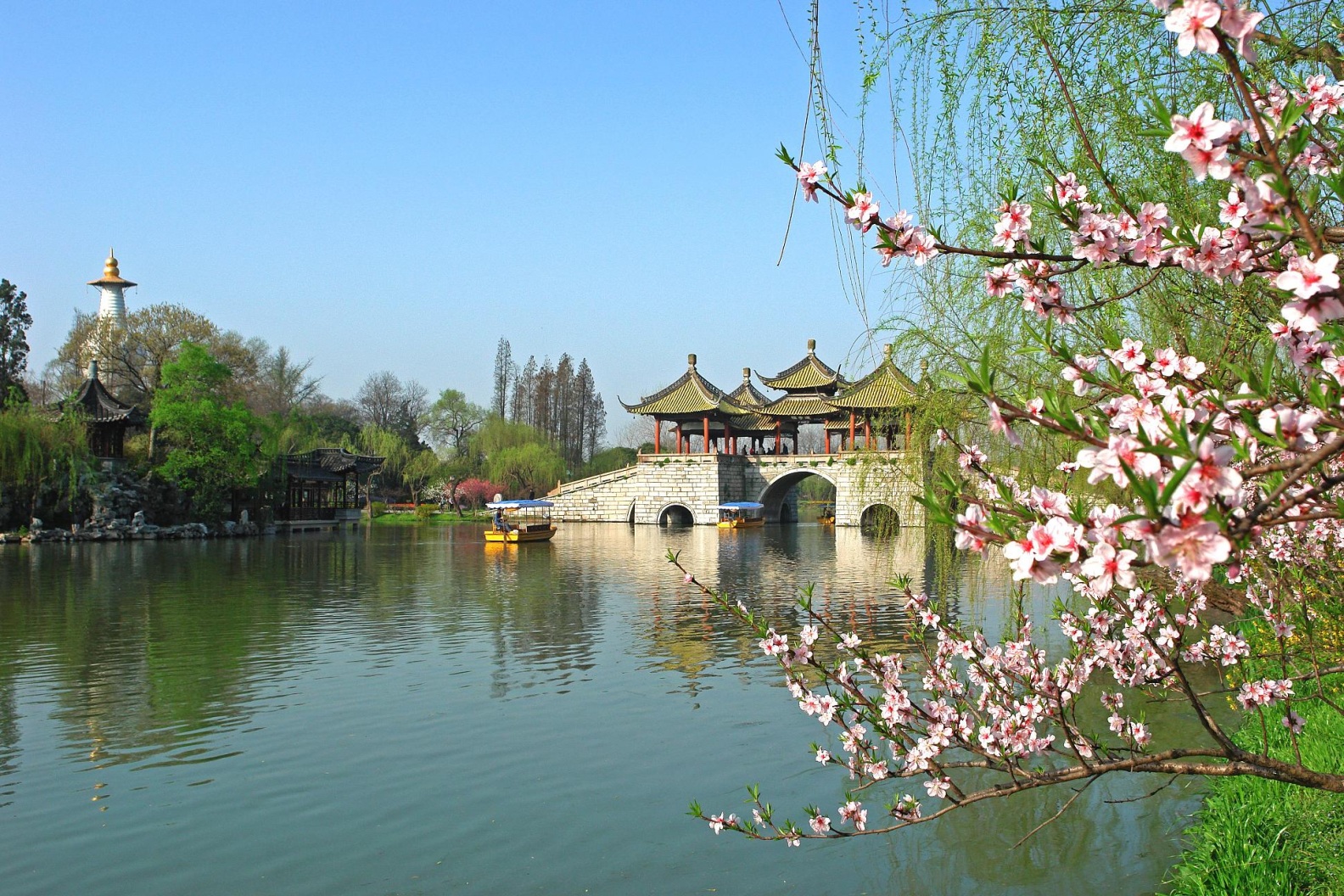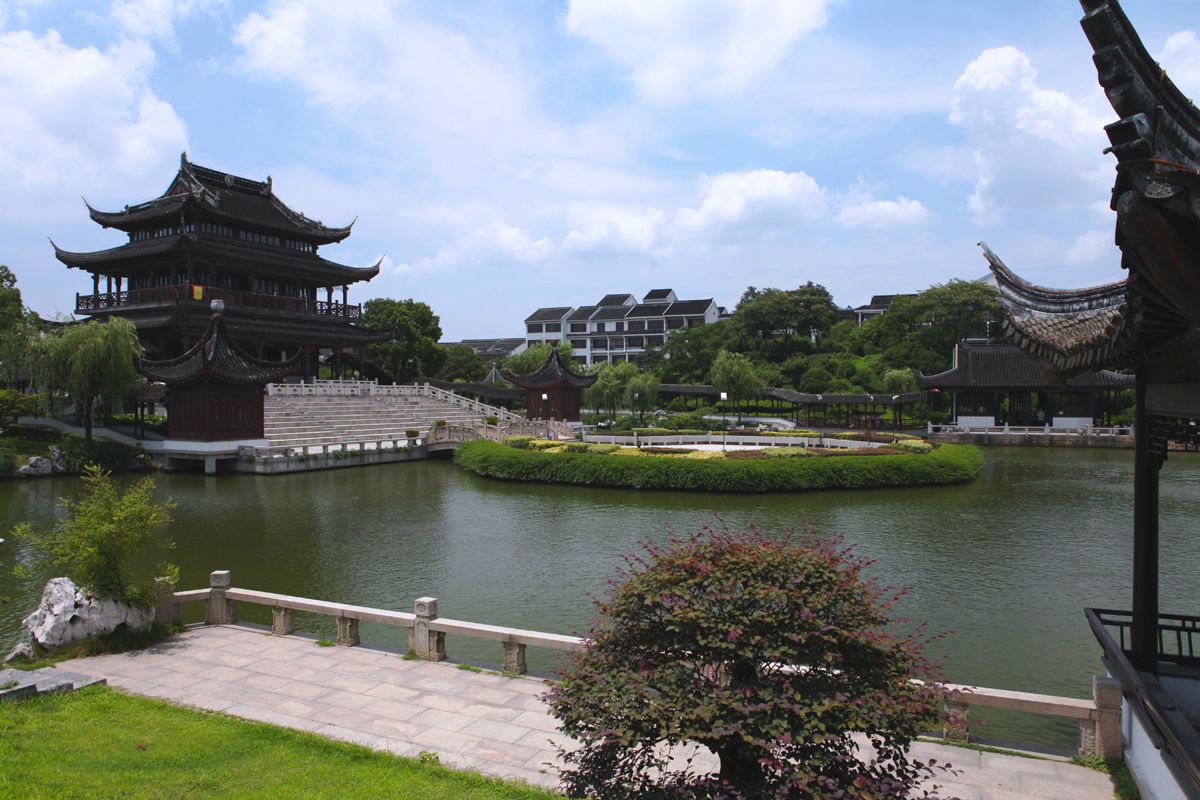German — Chinese

 *Changjiang|Yangtze River
*Changjiang|Yangtze River
 Beijing Shi-BJ
Beijing Shi-BJ
 China
China

 History
K 500 - 1000 AD
History
K 500 - 1000 AD
 Hebei Sheng-HE
Hebei Sheng-HE
 Jiangsu Sheng-JS
Jiangsu Sheng-JS
 Beijing-Hangzhou Grand Canal
Beijing-Hangzhou Grand Canal
 Shandong Sheng-SD
Shandong Sheng-SD
 Tianjin Shi-TJ
Tianjin Shi-TJ

 World Heritage
World Heritage

 Science and technology
Science and technology
 Zhejiang Sheng-ZJ
Hangzhou
Zhejiang Sheng-ZJ
Hangzhou




大运河南起余杭(今杭州),北到涿郡(今北京),途经今浙江、江苏、山东、河北四省及天津、北京两市,贯通海河、黄河、淮河、长江、钱塘江五大水系,全长约1797公里。运河对中国南北地区之间的经济、文化发展与交流,特别是对沿线地区工农业经济的发展起了巨大作用。
Der Kaiserkanal im Osten von China verläuft von der Stadt Hangzhou bis in die Hauptstadt des Landes, Peking. Die Stadt Hangzhou liegt in der Nähe von Shanghai und der Mündung des Changjiang-Flusses (im Westen oft auch Yangtsekiang-Fluss genannt), über Jahrtausende einer der fruchtbarsten Regionen Chinas. Die chinesischen Kaiser ließen den Großen Kanal anlegen, um Tributzahlungen und Naturalien-Steuern aus dem Süden des Landes in die Hauptstadt zu transportieren.
Auf chinesische heißt der Kaiserkanal 京杭大运河 Jing-Hang Da Zunhe, was übersetzt "Großer Beijing-Hangzhou Kanal" heißt. Im Westen wird der künstliche Fluss dagegen meist als Großer Kanal oder auch Kaiserkanal bezeichnet. Mit über 1800 Kilometern Gesamtlänge ist der Kaiserkanal die größte von Menschen geschaffene Wasserstraße der Welt. Der im Verlauf von vielen Jahrhunderten immer wieder ausgebaute Große Kanal ist teilweise bis zu 40 Metern breit und bis zu 9 Metern tief.(Quelle: http://www.forumchina.de/kaiserkanal)
Der Kaiserkanal (chinesisch 京杭大运河, Pinyin Jīng Háng Dà Yùnhé, d. h. Peking-Hangzhou Großer Kanal) ist die längste von Menschen geschaffene Wasserstraße der Welt. Mit einer Länge von mehr als 1800 Kilometern und einer Breite von bis zu 40 Metern verband er den Norden Chinas (Peking) mit dem fruchtbaren Mündungsgebiet des Jangtsekiang (Hangzhou). Er überwand einen Höhenunterschied von 42 Metern, war 3 bis 9 Meter tief und gilt als das Meisterwerk der Wasserbaukunst im alten China. Seit 2014 gehört er daher zum Welterbe der Menschheit.
京杭大運河(けいこうだいうんが)は、中国の北京から杭州までを結ぶ、総延長2500キロメートルに及ぶ大運河である。途中で、黄河と揚子江を横断している。戦国時代より部分的には開削されてきたが、隋の文帝と煬帝がこれを整備した。完成は610年。運河建設は人民に負担を強いて隋末の反乱の原因となったが、運河によって経済の中心地江南と政治の中心地華北、さらに元のクビライ・ハーンによって軍事上の要地である涿郡だった大都(後の北京)が結合して、中国統一の基盤が整備された。この運河は、その後の歴代王朝でもおおいに活用され、現在も中国の大動脈として利用されている。2014年の第38回世界遺産委員会でシルクロードなどとともに世界遺産リストに登録された。
The Grand Canal, known to the Chinese as the Beijing–Hangzhou Grand Canal (Jīng-Háng Dà Yùnhé), a UNESCO World Heritage Site, is the longest as well as the oldest canal or artificial river in the world and a famous tourist destination.[1] Starting at Beijing, it passes through Tianjin and the provinces of Hebei, Shandong, Jiangsu and Zhejiang to the city of Hangzhou, linking the Yellow River and Yangtze River. The oldest parts of the canal date back to the 5th century BC, but the various sections were first connected during the Sui dynasty (581–618 AD). Dynasties in 1271-1633 significantly rebuilt the canal and altered its route to supply their capital Beijing.
The total length of the Grand Canal is 1,776 km (1,104 mi). Its greatest height is reached in the mountains of Shandong, at a summit of 42 m (138 ft).[2] Ships in Chinese canals did not have trouble reaching higher elevations after the pound lock was invented in the 10th century, during the Song dynasty (960–1279), by the government official and engineer Qiao Weiyue.[3] The canal has been admired by many throughout history including Japanese monk Ennin (794–864), Persian historian Rashid al-Din (1247–1318), Korean official Choe Bu (1454–1504), and Italian missionary Matteo Ricci (1552–1610).[4][5]
Historically, periodic flooding of the Yellow River threatened the safety and functioning of the canal. During wartime the high dikes of the Yellow River were sometimes deliberately broken in order to flood advancing enemy troops. This caused disaster and prolonged economic hardships. Despite temporary periods of desolation and disuse, the Grand Canal furthered an indigenous and growing economic market in China's urban centers since the Sui period. It has allowed faster trading and has improved China's economy. The southern portion remains in heavy use to the present day.
Le Grand Canal (chinois simplifié : 大运河 ; chinois traditionnel : 大運河 ; pinyin : ) de Chine, également connu sous le nom de Grand Canal Pékin-Hangzhou (chinois simplifié : 京杭大运河 ; chinois traditionnel : 京杭大運河 ; pinyin : ) est le plus grand canal ancien ou rivière artificielle du monde (1 794 km). Les parties les plus anciennes remontent au Ve siècle av. J.-C.. Il est inscrit au patrimoine mondial de l'UNESCO depuis 20141.
Il Gran Canale della Cina, conosciuto anche come Gran Canale Jing-Hang e Canale Imperiale, è il canale o fiume artificiale più lungo del mondo e collega Pechino, passando per Tianjin e le provincie di Hebei, Shandong, Jiangsu e arrivando a Hangzhou nello Zhejiang e collega il fiume giallo e il fiume azzurro in Cina[1].
El Gran Canal de China (chino tradicional: 大運河, chino simplificado: 大运河, pinyin: Dà Yùnhé), conocido también como Gran Canal Pekín-Hangzhou (chino tradicional: 京杭大運河, chino simplificado: 京杭大运河, pinyin: Jīng Háng Dà Yùnhé) es el canal o río artificial más largo del mundo.1
En junio de 2014, la Unesco eligió el Gran Canal de China como Patrimonio de la Humanidad.2
En el año 604, el emperador Yang Guang de la dinastía Sui dejó la capital, Chang'an (en Xian) para trasladarse a Luoyang. En 605, el emperador ordenó la construcción de dos proyectos: transferir la capital del país a Luoyang (en Henan) y excavar el Gran Canal entre Pekín y Hangzhou.
En su origen se trataba de una serie de vías hidráulicas en la provincia Cheklang, al norte de China, que convergían con la ciudad de Pekín y Tianjin, atravesando las provincias de Hebeng, Shandong, Jiangsu y Zhejiang.
La construcción comenzó durante la dinastía Sui (581-618) y llegó a cubrir poco más de 1.700 kilómetros. Su nombre original era Da Yunhe, y en su tiempo constituyó el canal de agua más largo del mundo hecho por el hombre. Su misión era satisfacer las necesidades de las ciudades importantes con el agua de los ríos Yangste y Hual; permaneció en activo hasta el siglo XIX y después sufrió una serie de modificaciones, que en muchos casos culminaron en desastrosas inundaciones, y varias secciones se deterioraron hasta quedar separadas del cuerpo principal del canal.
Actualmente está dividido en siete subcanales, algunos de ellos muy contaminados, para el servicio exclusivo de aguas negras en desuso o con niveles insuficientes para la navegación. Pero los más grandes, como el canal Li y el Jiangnan son utilizados actualmente para el transporte de carbón y otros materiales; se estima que anualmente se mueven 100 millones de toneladas de carga.
Вели́кий кана́л[1] (кит. трад. 大運河, упр. 大运河, пиньинь: Dà Yùnhé — Даюньхэ[2]) — судоходный канал в Китае, одно из древнейших ныне действующих гидротехнических сооружений мира.
Строился в течение двух тысяч лет — с VI в. до н. э. до XIII в. н. э.[3] В настоящее время является одной из важнейших внутренних водных артерий КНР, соединяет крупные порты страны Шанхай и Тяньцзинь.
Протяжённость канала — 1782 км[4], а с ответвлениями в Пекин, Ханчжоу и Наньтун — 2470 км. Ширина в наиболее узкой части в провинциях Шаньдун и Хэбэй — 40 м, в самой широкой части в Шанхае — 350 м. Глубина фарватера — от 2 до 3 м. Канал оборудован 21 шлюзом. Максимальная грузопропускная способность составляет 10 млн тонн в год.
Канал соединяет реки Хуанхэ и Янцзы, включая в себя русла таких рек, как Байхэ, Вэйхэ, Сышуй и других, а также несколько озёр.
Великий канал состоит из нескольких сооружённых в разное время участков. Самый южный участок проложен в VII веке, самый северный — в XIII веке, а часть центрального участка от Хуайинь до Цзянду проходит по древнему каналу Ханьгоу.
Астронавт Уильям Поуг, будучи на борту Скайлэба, первоначально подумал, что увидел Великую Китайскую стену, но оказалось, что он видел Великий канал Китая[5].










